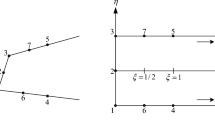Abstract
Seismic analyses of concrete gravity dams are usually idealized as two-dimensional structures with a massless foundation in present design procedure. But for gravity dams built in narrow valleys or on sites of very high seismicity, however, interaction between adjacent blocks may influence the seismic responses significantly. Dynamic interaction between dam and foundation affects the dam response as well, including reflection, diffraction and radiation of seismic waves. In the paper, a three-dimensional FEM full dam model was adopted to analyze the seismic responses of a concrete gravity dam, in which, dynamic interaction between dam-foundation, dam-water, energy radiation, dynamic contact between monoliths, etc. were taken into consideration. Comparison was made among the numerical results of a full dam model with a massless foundation, full dam model with or without contraction joints, differences between them and realistic understanding were discussed and proposals were given to improve the aseismic capacity of concrete gravity dams.
Similar content being viewed by others
References
El-Nady AM (1992) Seismic analysis of concrete gravity dams with keyed contraction joints. Open access dissertations and theses, Paper 3502, McMaster University
Ghaemmaghami AR, Ghaemian M (2010) Shaking table test on small-scale retrofitted model of Sefid-rud concrete buttress dam. Earthq Eng Struct Dyn 39(1): 109–118. doi:10.1002/eqe.928
Knarr M et al (2011) The investigation of a concrete gravity dam in a narrow Canyon using 3-D nonlinear analysis, 21st century dam design—advances and adaptations. In: 31st Annual USSD conference, San Diego, CA, April 11–15
Lysmer J et al (1975) FLUSH—a program for approximate 3-D analysis of soil-structure interaction problems. Report no. EERC 75-30. Earthquake Engineering Research Center, University of California, Berkley
Ministry of Power Industry (2000) Specifications for seismic design of hydraulic structures (DL 5073-2000), Beijing
Scheulen F, von Gersdorff N, Duron Z, Knarr M (2010) Numerical model validation for large concrete gravity dams. In: 30th Annual USSD conference
US Army Corps of Engineers (2007) Earthquake design and evaluation of concrete hydraulic structures. EM 1110-2-6053, 1 May
Westergaard HM (1933) Water pressures on dams during earthquakes transaction. Am Soc Civil Eng 98: 418–433
Zhang S, Wang H (2008) Equivalent viscous boundary elements and the method of wave input for viscous boundary. J Hydraul Eng 39(10):1248–1255 (in Chinese)
Author information
Authors and Affiliations
Corresponding author
Rights and permissions
About this article
Cite this article
Wang, H., Feng, M. & Yang, H. Seismic nonlinear analyses of a concrete gravity dam with 3D full dam model. Bull Earthquake Eng 10, 1959–1977 (2012). https://doi.org/10.1007/s10518-012-9377-4
Received:
Accepted:
Published:
Issue Date:
DOI: https://doi.org/10.1007/s10518-012-9377-4




